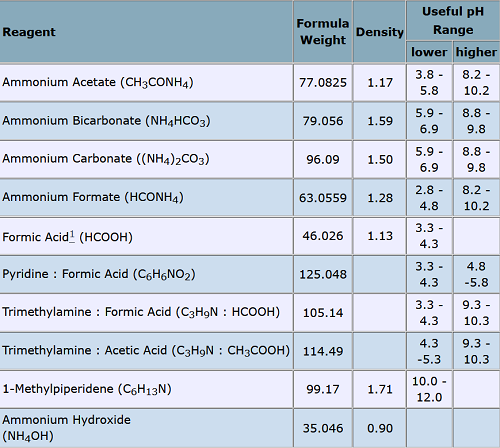| Identification | More | [Name]
Ammonium formate | [CAS]
540-69-2 | [Synonyms]
AMMONIUM FORMATE
AMMONIUM FORMIATE
FORMIC ACID, AMMONIUM
FORMIC ACID AMMONIUM SALT
formated’ammonium
mravencanamonny
AMMONIUM FORMAT
Ammonium formate, Eluent additive for LC-MS
AMMONIUM FORMATE, 99.995+% METALS BASIS
AMMONIUM FORMATE REAGENT GRADE 97%
AMMONIUM FORMATE SOLUTION 10M
AMMONIUM FORMATE PURE
AmmoniumFormateAr
AmmoniumFormateReagent
AmmoniumFormateGr
Ammoniumformate,99%
Ammoniumformate,97%
AMMONIUM FORMATE SOLUTION
AMMONIUMFORMATE,CRYSTAL,REAGENT
Ammonium formate, 97%, water <3% | [EINECS(EC#)]
208-753-9 | [Molecular Formula]
CH5NO2 | [MDL Number]
MFCD00013103 | [Molecular Weight]
63.06 | [MOL File]
540-69-2.mol |
| Chemical Properties | Back Directory | [Appearance]
colourless crystals | [Melting point ]
119-121 °C (lit.) | [Boiling point ]
103.28°C (rough estimate) | [density ]
1.26 g/mL at 25 °C(lit.)
| [vapor pressure ]
0.033Pa at 25℃ | [refractive index ]
1.4164 (estimate) | [Fp ]
104℃ | [storage temp. ]
Store at RT. | [solubility ]
H2O: 10 M at 20 °C, clear, colorless
| [form ]
Solid | [color ]
White | [Odor]
Slight formic acid odour | [PH]
6.0-8.0 (25℃, 10M in H2O) | [PH Range]
6 - 7 | [Stability:]
Stable. Hygroscopic. Incompatible with strong acids, strong oxidizing agents. | [Water Solubility ]
soluble | [Sensitive ]
Hygroscopic | [λmax]
λ: 260 nm Amax: 0.05
λ: 280 nm Amax: 0.04 | [Merck ]
14,523 | [BRN ]
3625095 | [InChIKey]
VZTDIZULWFCMLS-UHFFFAOYSA-N | [LogP]
-3.34 at 25℃ | [CAS DataBase Reference]
540-69-2(CAS DataBase Reference) | [EPA Substance Registry System]
540-69-2(EPA Substance) |
| Safety Data | Back Directory | [Hazard Codes ]
Xi | [Risk Statements ]
R36/37/38:Irritating to eyes, respiratory system and skin . | [Safety Statements ]
S26:In case of contact with eyes, rinse immediately with plenty of water and seek medical advice .
S36:Wear suitable protective clothing .
S37/39:Wear suitable gloves and eye/face protection . | [WGK Germany ]
2
| [RTECS ]
BQ6650000
| [F ]
3-10 | [TSCA ]
Yes | [HS Code ]
29151200 | [Hazardous Substances Data]
540-69-2(Hazardous Substances Data) | [Toxicity]
LD50 orl-mus: 2250 mg/kg ZERNAL 9,332,69 |
| Raw materials And Preparation Products | Back Directory | [Raw materials]
Ammonia-->Formic acid-->4-Chlorobenzaldehyde | [Preparation Products]
2,5-Dimethoxybenzylamine-->Triadimefon-->C-(1-METHYL-PIPERIDIN-2-YL)-METHYLAMINE-->5-Azaindole-->1,2,4-Triazole-->3-Azetidinecarboxylic acid-->5-amino-1H-Indole-2-carboxylic acid ethyl ester-->1-N-Boc-3-hydroxyazetidine-->3-Amino-5-fluoropyridine-->5-Fluoro-2-picolinic acid-->4-(Trifluoromethyl)nicotinic acid-->ETHYL 5-AMINO-1H-INDOLE-2-CARBOXYLATE-->4-CHLORO-7-METHYLTHIENO[3,2-D]PYRIMIDINE-->(4S)-HYDROXY-3-METHYL-2-(2-PROPENYL)-2-CYCLOPENTENE-1-ONE-->7-Methylthieno[3,2-d]pyrimidin-4(3H)-one-->3-Amino-4-methoxybenzoic acid-->3-(4-Morpholinyl)aniline-->3-Chlorobenzylamine-->5-CHLORO-1H-INDAZOLE-3-CARBOXYLIC ACID-->DL-ALPHA-METHYLBENZYLAMINE-->(1,3,5-TRIMETHYL-1H-PYRAZOL-4-YL)METHYLAMINE-->4-METHYL-1,3-OXAZOLE-5-CARBOXYLIC ACID-->4-METHYLOXAZOLE-5-CARBONYL CHLORIDE-->3,5-Bis(trifluoromethyl)benzylamine-->4-CHLORO-2-METHYLBENZYLAMINE-->5-(AMINOMETHYL)-2,3-DIHYDROBENZO[B]FURAN-->Teicoplanin A2-->DL-alpha-Methylbenzylamine-->(R)-(-)-2-AMINOHEPTANE-->3,4,5-Trimethoxybenzylamine-->(1H-INDAZOL-3-YL)-ACETIC ACID-->Citrazinic acid-->4-Hydroxy-3-methoxybenzylamine hydrochloride-->4-Aminotetrahydropyran |
| Hazard Information | Back Directory | [General Description]
White solid with a weak odor of ammonia. Sinks and mixes slowly with water. | [Reactivity Profile]
Salts, basic, such as AMMONIUM FORMATE(540-69-2), are generally soluble in water. The resulting solutions contain moderate concentrations of hydroxide ions and have pH's greater than 7.0. They react as bases to neutralize acids. These neutralizations generate heat, but less or far less than is generated by neutralization of the bases in reactivity group 10 (Bases) and the neutralization of amines. They usually do not react as either oxidizing agents or reducing agents but such behavior is not impossible. | [Air & Water Reactions]
Water soluble. | [Health Hazard]
Inhalation causes irritation of nose and throat. Ingestion irritates mouth and stomach. Contact with eyes or skin causes irritation. | [Fire Hazard]
Special Hazards of Combustion Products: Toxic and irritating ammonia and formic acid gases may form in fire. | [Description]
Ammonium formate, NH4HCO2, is the ammonium salt of formic acid. It is a colorless, hygroscopic, crystalline solid. It can be synthesized through treating ammonium carbonate with 85% formic acid. It is widely used in many organic reactions such as Leuckart reaction which is the reductive amination of aldehydes and ketones. It can also be used as a buffer in HPLC and LC/MS test. Moreover, it is also used in palladium on carbon (Pd/C) reduction of functional group. It can also be used for the preparation of formic acid in situ as well as being used to store formic acid.

Common HPLC Buffers: Ammonium formate (2.7<PH<3.7) does a fairly good job of filling the gap at the low-pH end. | [Chemical Properties]
colourless crystals | [Physical properties]
White monoclinic deliquescent crystals or granules; density 1.280 g/cm3; melts at 116°C; highly soluble in water (102 g/100 g at 0°C), solubility rapidly increasing with temperature (i.e., 531 g/100 g at 80°C); soluble in liquid ammonia, alcohol and ether. | [Uses]
In chemical analysis, especially to ppt base metals from salts of the "noble" metals. | [Uses]
Pure ammonium formate decomposes into formamide and water when heated, and this is its primary use in industry. Formic acid can also be obtained by reacting ammonium formate with a dilute acid, and since ammonium formate is also produced from formic acid, it can serve as a way of storing formic acid.
Ammonium formate can also be used in palladium on carbon (Pd / C) reduction of functional groups. In the presence of Pd / C, ammonium formate decomposes to hydrogen, carbon dioxide, and ammonia.
Ammonium formate can be used for reductive amination of aldehydes and ketones (Leuckart reaction)
Ammonium formate can be used as a buffer in high performance liquid chromatography (HPLC), and is suitable for use with liquid chromatography/mass spectrometry (LC/MS). . | [Definition]
ChEBI: The ammonium salt of formic acid. | [Reactions]
When heated, ammonium formate eliminates water, forming formamide. Upon further heating it forms to HCN and H2O. A side reaction of this is the decomposition of formamide to CO and NH3. | [Flammability and Explosibility]
Notclassified | [Safety Profile]
Moderately toxic by ingestion andintravenous routes. When heated to decomposition itemits toxic fumes of NOx and NH3. | [Purification Methods]
Heat the solid in NH3 vapour and dry it in a vacuum till the NH3 odour is faint (note that it can evaporate completely in a vacuum). Recrystallise it from absolute EtOH and then keep it in a desiccator over 99% H2SO4 in vacuo. It is very hygroscopic. It exists in two forms, stable needles and less stable plates. It also forms acid salts, i.e. HCO2NH4.3HCO2H and HCO2NH4.HCO2H. [Kensall & Adler J Am Chem Soc 43 1473 1921, Beilstein 2 IV 18.] |
|
|